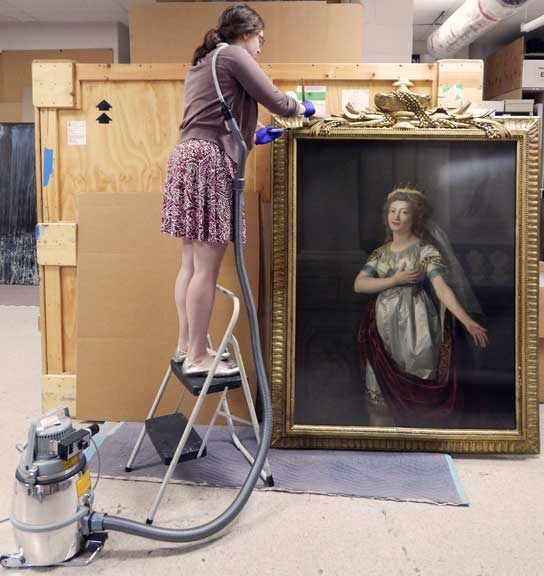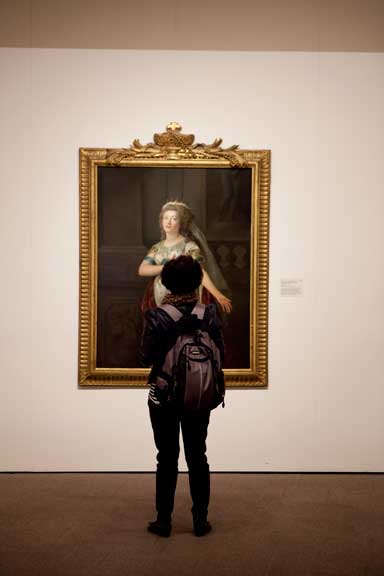Visitors to the National Museum of Women in the Arts have no doubt seen Anne Vallayer-Coster’s majestic portrait of Madame de Saint-Huberty in the Role of Dido, which currently hangs on the east wall of the mezzanine level. However, many do not understand the behind-the-scenes work involved in the preservation of this grand painting. While interning in the office of the registrar this summer, I learned about the various ways in which the office safeguards and organizes nearly 5,000 works in the collection.

Believe it or not, dusting is one of the most important preventive measures undertaken by the registrars. Dust hardens like cement, so these pesky particles can actually damage objects if ignored for too long. On one afternoon, I learned how to gently remove the dust that had accumulated within the intricate floral frame surrounding Madame de Saint-Huberty in the Role of Dido.
With slow and careful strokes, I brushed the dust of the small crevices, guiding it into the hose of a special low-suction HEPA vacuum positioned a safe distance from the surface of the painting. My brush never actually touched the surface of the paint, though. You may notice that many works are framed with a layer of glass in front, which shields the art from damaging debris. Even small measures like these can ensure a work’s long-term safety.
The registrars also carefully control the environment of the museum, for changes in temperature and humidity can have harmful effects on art. While we removed Madame de Saint-Huberty and other works for routine cleaning, the museum’s chief preparator improved the insulation inside the walls of the gallery space, guaranteeing that the paintings would be in a more protective environment. In fact, a temperature-controlled storage vault houses the majority of the museum’s collection inside massive crates, ceiling-high filing systems, and cocoons of bubble wrap. Only three percent of the collection’s 4,800 works are actually on display!

While working within the maze of art storage, I began to realize that keeping accurate records is equally as important as ensuring the physical safety of the collection. After all, how could we study a sculpture without knowing the basic information about it, or even where to locate it? For the past year, the office of the registrar has been working on a collections inventory to ensure the intellectual safety of the objects. Throughout the summer, I helped photograph, measure, and document hundreds of works on paper, knowing that all of this information would allow future scholars to better understand them.
Working behind the scenes these past few months has given me a greater appreciation for the importance of safeguarding the physical and intellectual well-being of the art. After all, without preservation, education would not be possible. Visitors walk through NMWA’s gallery spaces because they want to learn about the groundbreaking accomplishments of women artists. The dedicated efforts of registrars and collections managers ensure that this experience may happen.
Click here to learn more about interning at the National Museum of Women in the Arts.
